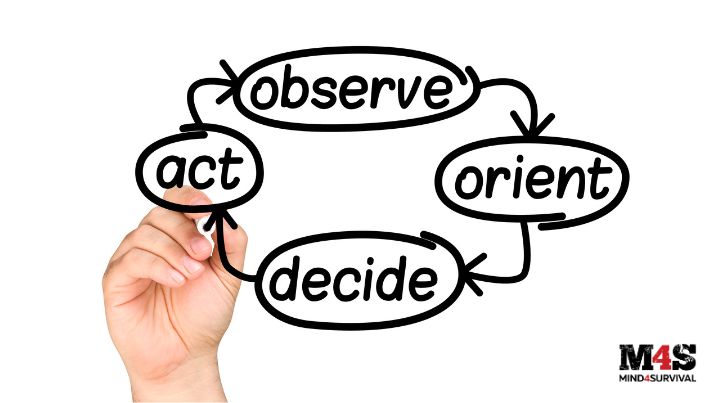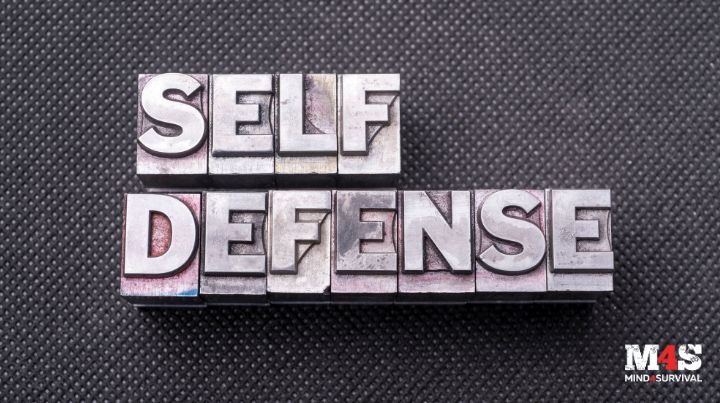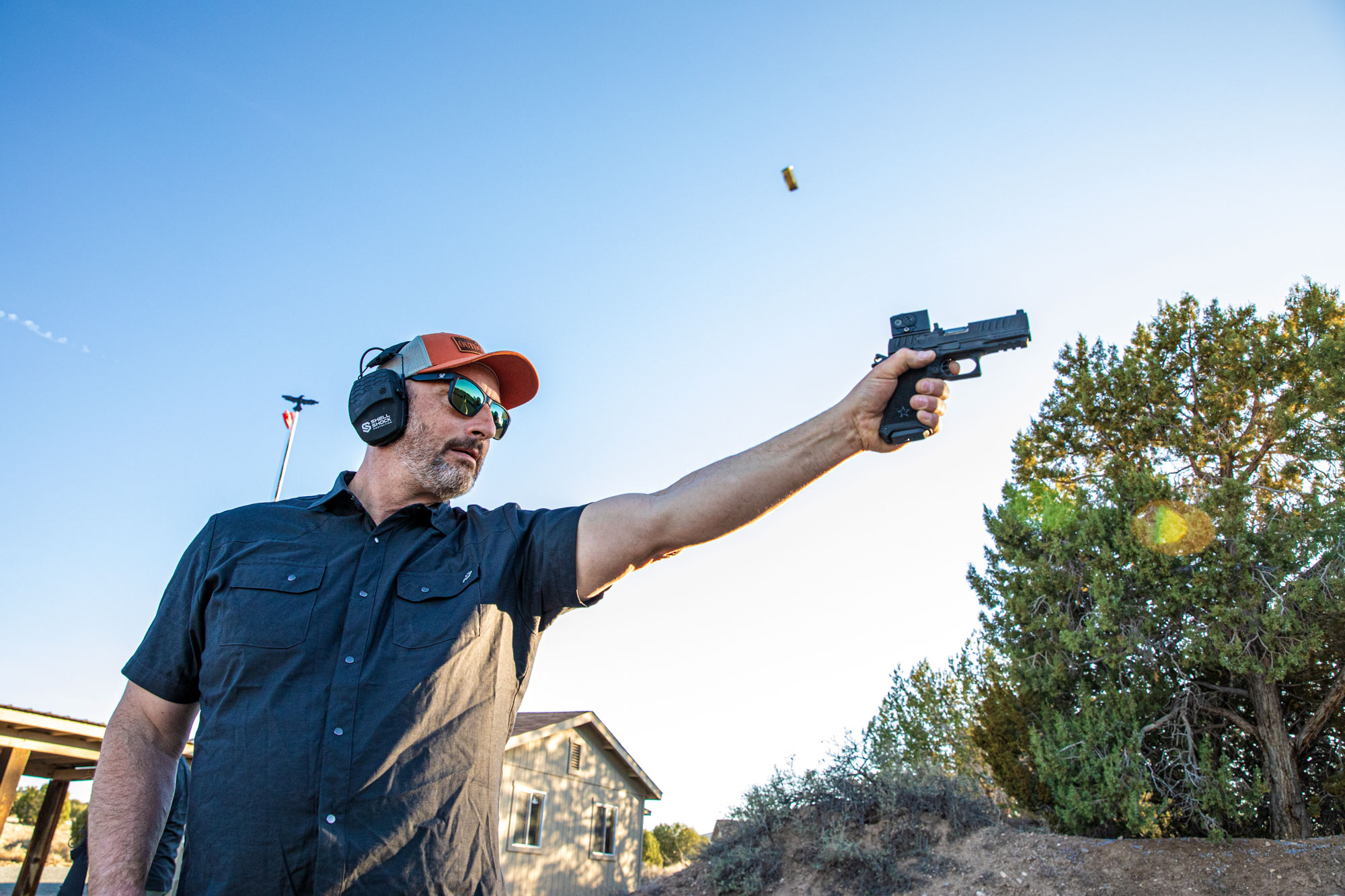A ‘Dream’ Hunt for Mountain Goats Means Whitewater, Sheer Cliffs, and Tough Shots

This story, “Idaho Goats Come High,” appeared in the July 1950 issue of Outdoor Life.
Ever since the day when, as a kid, I saw the profile of a Rocky Mountain goat on a Great Northern box car, I’d wanted to hunt that monarch of the rocks. Now the time had come; but, like misty dream clouds, banks of very real fog obscured my first view of mountainous terrain in the Idaho Bitterroots.
Since daybreak of this October morning we had been twisting and turning in our saddles trying to duck rain-saturated brush that dribbled moisture down our necks. The smell of wet leather and steaming sweat from the horses was exhilarating. And I was in fine spirits because, at last, I was heading into back country to hunt goats.
Below me, our pack string wound carefully back and forth over the switchbacks. The character riding at the end and grabbing leather with both hands was Lem, my hunting companion. Bert, the owner of the pack string, was ahead of the mules with Matt, his wrangler and packer.
This was the kind of hunt the average sportsman can afford, provided he has plenty of time, can be his own guide, and is able to rough it.
As the blanket of fog melted into the deep canyons, it revealed some of Idaho’s finest elk range — old burns, windfalls, and brush. The conifers were green and lush in the deep draws, and the willow and chaparral-studded ridges swept skyward to where mountains of granite were silhouetted against the sky.
Far below, a turbulent river wound like a ribbon through the dark canyons. We’d crossed that churning water nearly a week ago, and it had been a tough crossing. But let me start at the beginning….
It had rained all during our trip to Bert’s pack camp. The news, we quickly discovered, was about as damp as our travel gear. “We can’t pack you in this kind of weather,” Bert told us. “The river is too high. Maybe in a couple of days we can go over.”
A couple of days it was. But finally, at the break of dawn, we were cinching diamond hitches over our equipment on the six mules. Heading up the canyon, we began to search for a place where we could cross the river.
White water glistened in the early light, and the numerous rapids sprayed foam twice the normal height. A mile upstream, Bert reined in and pointed to a wide gap between rapids. “We may make it here,” he said.
I had my mind on goats and I wasn’t going to let a little white water interfere with my plans. “Let’s go!” I said. Matt and I went first, each leading two of the mules. As we began swimming our horses into the cold water I felt the powerful tug of the current. It was too fast! But the horses and mules were already in midstream and it was too late to retreat. I turned and yelled at Lem: “Don’t come in!” The roar of the river drowned my yell and on he came.
For the next few action-packed minutes Matt and I battled the current. It was as wild as it was unpredictable — but we were lucky. An erratic eddy snatched us out of the main current and pushed us toward the opposite shore. As soon as my horse had solid ground under him I swung around in the saddle. Lem and his horse were being sucked downstream toward the big rapids! I watched — helplessly — as Lem’s horse was caught and tossed backward like a cork. Lem was thrown into the churning maelstrom and was whipped and bashed against giant boulders. I heard his gasping cry for help. And then only one limp hand was visible above the lacy foam.
I watched — helplessly — as Lem’s horse was caught and tossed backward like a cork. Lem was thrown into the churning maelstrom and was whipped and bashed against giant boulders.
I dismounted and began scrambling belly-deep over boulders in a frantic effort to get below the rapids and swim out to Lem. But I couldn’t make it fast enough. When I got below the rapids Lem wasn’t in sight.
Bert was, though. I saw him reach into a swirling eddy and clutch at something bumping against the rocks. A moment later he pulled Lem out and draped him over a large boulder.
Matt and I raced back upstream. Some hundred yards above the original crossing the water was quieter. We plunged in and began swimming the swift current. Our heavy boots and clothes, left on in our haste, felt like lead.
Numb and bedraggled as half-drowned rats, we made the opposite shore and sprinted along it. By the time we reached Lem, Bert had brought him around. He was still dazed — but he was conscious. We took him back to camp. Then Matt returned to the river and found Lem’s horse limping along the rocky shore with the rifle still tied to the saddle. Matt found a less dangerous crossing farther upstream and managed to bring the other two horses and the four mules back. Then he led the entire string into camp.
It looked as though our hunt was over before we started. Badly bruised and sick with fever, Lem lay in bed for three days. But on the fourth day he was up and raring to go. We borrowed a skiff and motor from a lumber camp and got Lem across the river in style. Then we led the stock across and began climbing the mountainside. I looked down at the treacherous stream and felt victorious. Lem didn’t, though. He said he never wanted to see another river more than ankle-deep.
Planning the Campaign
Later that day when we stopped to rest the horses, I glassed the distant crags and soon picked up some white specks that looked like small patches of snow. As I watched, the fleecy specks moved against the background of dark rock. “Goats,” I said. “Lots of ’em.” Matt pushed back his weather-beaten hat and scratched his noggin. “If you can get a goat out of that rock pile, brother,” he remarked dryly, “you will earn it.”
Through the glasses, I had to admit, the goats looked pretty safe. Matt was right — they would be tough to get. But I was willing to earn one.
Lem was, too, although he was hardly strong enough to ride a horse, not to say climb around sheer cliffs of rock. But Matt predicted that in a week or two Lem would be scaling rockslides and giving the goats lots of competition.
Arriving at a saddle fairly protected with spruce and fir, we made camp. Then Bert and Matt left us, agreeing to come back for us at the end of the season.
Lem and I cooked up some coffee and then sat down with steaming cups to plan our campaign. Mountain storms were frequent and the autumn days were a preview of winter. We realized we couldn’t waste much time. But we wanted an elk, too, so we decided to try for one before they headed for lower areas. It was risky postponing our search for goats but we voted to take the chance. At first our luck wasn’t too good. When the wind wasn’t blowing, the fog lay in thick blankets and made hunting nearly impossible. We put in long days covering many miles of excellent elk range without success. Most of the herds, apparently, had already gone below. Rain turned to snow as we kept hunting. At last we got our elk — a straggler, but a good one. With juicy steaks on the menu and the quarters safely hung, we were finally ready to try our luck on goats.
Before dawn we crawled out of our sacks like a couple of groundhogs. Lem dived into a foot of snow to get an armload of firewood — and returned to the comparative warmth of the tent at an even faster pace. “Save some of that speed,” I advised. “You’ll need it.”
It was nearly as bright as day, with the moon lighting the snowy landscape, as we headed for the rocky terrain. The fresh snow was crisscrossed with tracks of all the animal life in the hills, it seemed. The trail was rough and treacherous; the weather was getting wintry, and if heavier snows fell, our bunt would get even more dangerous.
At the first granite ridge we headed into clouds of fog and it began to look discouraging. But we went on, and at a point overlooking a series of vast canyon walls we decided to sit it out until the fog cleared.
Lem wasn’t too cheerful as he sat on an icy rock rolling a cigarette. “Bet you never will get close enough to a goat to see him in your sights,” he said.
I noticed the fog clearing on the farthest ridge. I raised my glasses and scanned the entire area. As I was about to lower them I noticed a faint white speck on the apex of a canyon wall. “There’s one!” I said. Soon more white specks appeared and I let out a yell. “A dozen of ’em!”
Lem shucked his discouragement in a hurry. “Big ones?” he asked. I pointed out the area and passed the glasses to him. He counted six goats moving along the rocks and several lying down.
Well, there were our trophies. But between us and them were precipitous cliffs of solid granite. To our right was a high ridge with shoulder-high brush, stretching for a mile.
We decided to travel the ridge and, if possible, work down on the goats. In the thick chaparral just ahead of us, we heard the brush snap and the sound of hoofs skidding over the rocks. We froze, thinking we might have spooked some feeding goats. Then, less than fifty yards away, half a dozen deer bounded across a clearing.
Finally we reached the massive rock pile. We kept on the shady side, so as not to be conspicuous, and worked our way down a continuous granite mass which had a coating of ice that made it slick as a greased pole. We sat down and started sliding, reaching out occasionally to grab a sprig that grew out of a cleft in the rock. The icy slope soon became steeper and we slid faster. Below us was an abutment of black, jagged pinnacles. If we could slide straight, we’d eventually come to a halt.
We breathed freely again as our boots struck against solid support. “About time!” puffed Lem. “I’m not a mountain goat yet!” We were in the middle of a mass of ice-coated rock and one way looked as bad as another.
In a few minutes the goats would be on the other side. I hurried to the only place where I could possibly get a shot. It would be a long one, and after all the climbing over rock I was breathing hard.
But my mind was on goats, and if I could spot a likely trophy I was willing to try stalking it. I edged over the slippery rock, hoping for a better view. Then, peering between a grotesque rock formation and across a deep chasm, I saw three goats moving along a shelf toward a deep cut in the crags.
I motioned to Lem and crawled ahead. Now I could see more goats scattered over a wide area — some lying down, others feeding on moss or lichen.
When Lem joined me I pointed to the highest goat. As if it were a specimen mounted on the crag, I said, “There’s my trophy.” I felt as thrilled as a kid on his first rabbit hunt.
Looking at the old monarch through the glasses was a sight indeed. His ebony-colored horns and dark eyes glistened in contrast to the pure white coat. Standing on a narrow ledge, he was looking over his domain of pinnacles and crags, towering high above a misty canyon through which a turbulent stream wound endlessly.
We watched the goats for some time to be certain which way they were moving. I was going to stalk the old boy, and Lem chose to stay with me. Creeping slowly ahead on all fours, dodging behind boulders whenever we could, we saw the goats working up a narrow pass with the monarch ahead.
In a few minutes the goats would be on the other side. I hurried to the only place where I could possibly get a shot. It would be a long one, and after all the climbing over rock I was breathing hard. What a miracle if I connected! But I had to take the chance since this would probably be the only shot I’d get. I kneeled and took careful aim, holding the reticule of my scope-sighted .300 Savage over the goat as he climbed, and squeezed the trigger.
I gulped hard. The 180-grain bullet spattered against the rocks below the monarch and he fled over the rim. The remaining goats dodged over the rocks like popcorn out of a popper.
I was bitterly disappointed — but not licked yet. Hoping for a glimpse of the retreating goats, we climbed toward a craggy ridge. Lem took one side and I the other. Nothing in sight. We met, and began scanning the terrain again.
Far below, on a shale-strewn ridge, a lone goat was bouncing for parts unknown. While I sat admiring this acrobat, I heard rocks crashing but I couldn’t locate the source of the echoing sound. Finally, on the north canyon and across a deep gorge, I saw a goat leaping like a bullfrog over loose rock. Quickly adjusting my glasses, I saw a beautiful set of horns. It was the old monarch! Here was my break at last!
Hung on the Mountainside
The distance was not more than 300 yards. I felt confident as I grabbed my rifle, aimed, and squeezed off the shot. Hard hit, the goat rolled over, then staggered toward a precipice over which it might drop hundreds of feet. I snapped another shot. The goat collapsed and rolled over and over down the slide until it lodged against a scrubby patch of brush. There was my trophy draped precariously on the mountainside.
While Lem waited on a ledge above, I maneuvered down the walls of the chasm and over slide rock, until I finally reached the goat. Perched on a narrow shelf, I admired his ten-inch horns. One shot had penetrated the lung area and another had broken his back. Further examination was rudely interrupted by a rope which Lem snaked down and dangled in front of me.
With nothing but air below me, I watched the white, fluffy animal dangling and spinning at the end of the rope.
I tied the rope around the goat’s neck, then climbed to the ledge where Lem was waiting. While Lem braced his feet and hauled on the rope, I stretched out, belly-down, and pushed head and shoulders beyond the shelf. Suspended like that, with nothing but air below me, I watched the white, fluffy animal dangling and spinning at the end of the rope. When it came closer I reached out and seized one of the horns. As Lem kept the rope taut I managed to heave the goat onto the shelf. Then for a minute or two Lem and I sat back and rested. We were puffing and blowing like a couple of switch engines.
“Well,” I said finally, “we’ve still got a long way to go.”
Lem didn’t seem very pleased at the prospect, but he held the goat from sliding while I skinned it out. Examining the pelt we could understand why goats are hard to kill. The pelage is thick and shaggy, and the undercoat is closely matted; by the time a bullet enters into this mass, cuts the coarse fibers, and penetrates the flesh it has lost a lot of energy.
Lem Gets His Chance
I strapped the heavy hide and head on my back. Lem packed the meat and we began scaling the steep, slippery terrain. At one particularly treacherous spot as I paused to find safe footing I saw a goat bouncing up the next ridge. “There’s a goat, Lem!” I shouted.
At that instant the animal ambled out from behind a large boulder and stood on the granite outcropping at the edge of a sheer cliff. We couldn’t estimate the size of the horns too well, but Lem didn’t hesitate. He dropped his pack and brought up his rifle. The bullet from the .30/06 caught the goat squarely. Instead of going down, though, it bounced higher. After another bullet caught him, he rolled over, made a sheer drop of hundreds of feet, and landed in a maze of brush.
It took us the better part of an hour to reach Lem’s billy — a fine specimen with nine-inch horns. It took another hour to return to the trail. We skinned the carcass, loaded up once again, and set out toward camp. We had to climb carefully because if we started the loose rock falling, we too might go tumbling to the jittery depths below. Many times the trail ended in sheer, solid rock and we had, to back-track. Testing the fissures for solid support, we pulled ourselves up the ledges cautiously. As the sun began to sink behind the bleak canyon walls the air became chilled but the warm, woolly hide on our backs caused rivulets of perspiration.
We kept going, scrambling and toiling for what seemed hours, until we reached level ground. I turned and looked back on the domain of the monarchs of the rocks. The sun had set behind the ridges and the vast, perpendicular masses of granite were shadowy and dark. After that majestic view, even the sight of our camp was an anticlimax — but a welcome one. We hung up our trophies and stowed the meat, then ate a hurried supper and turned in.
Dreams? Not a one; what further need of dreams, when the ones you’ve had come true?
Read the full article here







